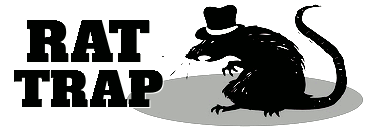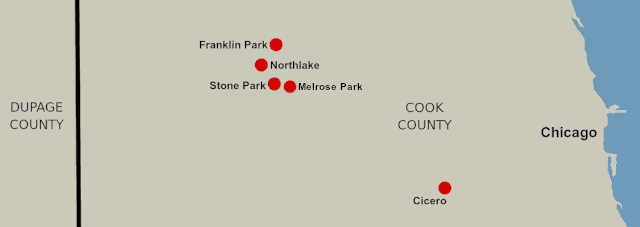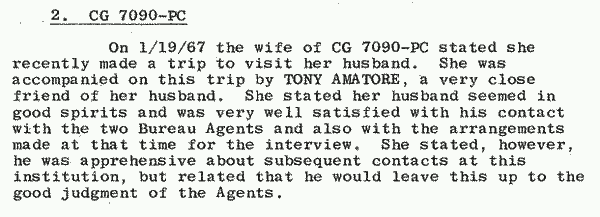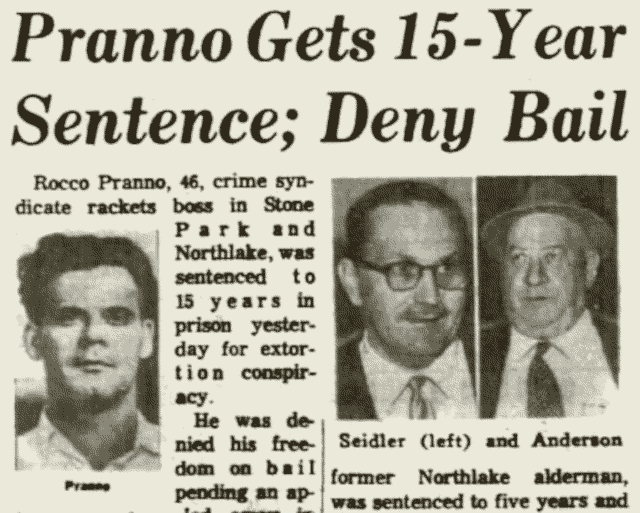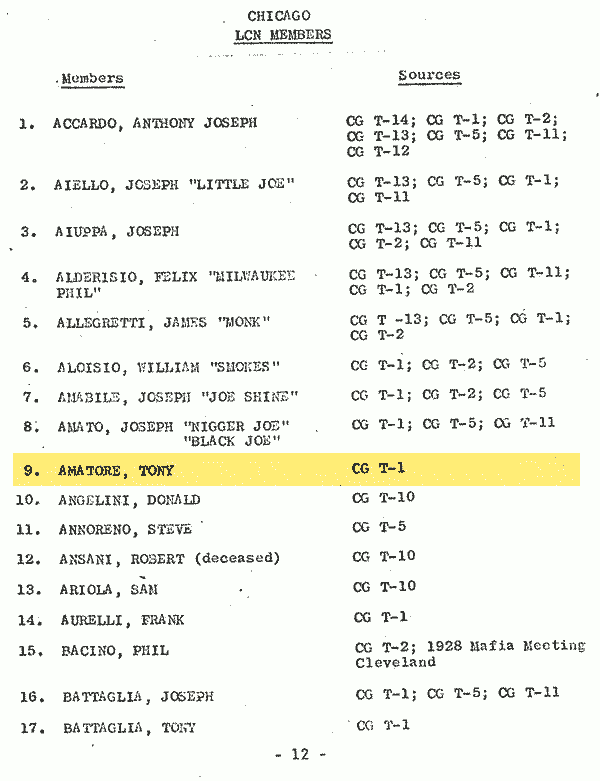Stone Park, Illinois, is a small, working-class community five miles west of Chicago. It sprung up after World War II, as the population spread out from Chicago to the suburbs looking for cheap housing and green space. The village became a magnet for hardworking people looking for a fresh start and something to call their own.
But Stone Park also attracted a criminal element that brought gambling, prostitution and a level of civic corruption that was a throwback to another era. After the Chicago Outfit moved in, Stone Park became the playground of hoodlums bent on squeezing out every last penny from any crooked scheme. Things were so bad that Stone Park became known state-wide as "Hoodsville, Illinois."
Besides becoming a byword for vice, Stone Park held another distinction unknown to everyone outside of the Federal Bureau of Investigation: two Outfit members who lived in the Stone Park-area were confidential informants. One was an obscure mobster who had the unique position of being on both sides of the law, while the other was a prominent gangster who ruled his territory with an iron fist.
The two mobsters were friends and criminal associates, but that didn't stop them from telling on each other. They were among the very first La Cosa Nostra members from Chicago to betray their oath of silence. Their cooperation would probably have never seen the light except for clues in an FBI report that inadvertently exposed them.
FBI Report
A report produced by the FBI's Chicago office on January 20, 1967, is the key to determining the identity of the two informants. It shows the development of informants and their recent activities.
Ordinarily, reports of this kind would have been made public with key identifying factors blacked out, but some have been declassified recently with only a small number of redactions. This report doesn't refer to the informants by name but uses informant symbol codes to protect their anonymity.
CG-6933-C-TE
On January 15, 1967, an FBI informant known only as "CG-6933-C-TE" traveled from Chicago to the federal penitentiary at Terre Haute, Indiana. [1] The purpose of his trip was to visit imprisoned mobster Rocco Pranno. Pranno's wife, Martha, joined the informant on the visit.
Rocco Pranno was an Outfit crew boss who oversaw criminal activities in the Stone Park/Northlake area in the western suburbs of Chicago. He had a brutal reputation and had a long prison record. Pranno came to national attention in 1959 when Robert Kennedy and a U.S. Senate committee investigating the mob highlighted his criminal activities on television.
At the time of the informant's prison visit in 1967, Pranno was appealing a fifteen-year prison sentence for extortion. According to "CG-6933-C-TE," who reported details to his FBI handlers afterward, Pranno was a bitter man when they met. Pranno believed his associates in the Outfit had "sold him out." He complained to the informant that his attorney, Richard Devine, had done a poor job of defending him in his criminal case. [2] Pranno told the informant that he hoped his appeal went better than his trial.
At the same time "CG-6933-C-TE" was visiting Pranno, another FBI informant was receiving a visit from his spouse. [3] The details of this second visit were included in the same part of the report.
Breaking down "CG-6933-C-TE"
"CG" is the code for the Chicago field office. "CG" means the informant lives in the area covered by the Chicago field office. The number "6933" refers to the informant and is unique to the field office. The "C-TE" is a top echelon source. This designation signifies the mobster is valuable and regularly shares Intel with the FBI. A potential criminal informant or "PC" indicates he's a new source.
CG-7090-PC
In January 1967, a different informant, "CG-7090-PC," was meeting with his spouse. [4] (The informant's wife's name wasn't used in the report to protect his anonymity.) The meeting location was left vague (almost certainly because it points to the identity of the informant), but inferences can be drawn that point to prison.
For example, "CG-7090-PC," the report states, was appealing his "case" through his attorney Richard Devine. The report indicates the spouse needed to "visit" the informant and that he was "apprehensive" about meeting FBI agents "at this institution." Furthermore, "CG-7090-PC" advised his wife that he hoped the FBI could "help" him. This suggests the informant was having legal trouble.
Joining the unnamed spouse on the visit to see "CG-7090-PC" was "a very close friend of her husband" named Anthony Amatore. Amatore was a former Stone Park police officer. He was identified as a La Cosa Nostra member by Outfit member-informant Louis Fratto.
CG-7090-PC revealed
Examining the description and activities of both informants in light of one another links "CG-7090-PC" with Rocco Pranno and "CG-6933-C-TE" with Anthony Amatore.
CG-7090-PC and Pranno match in five areas:
- They were imprisoned.
- They were visited by a wife and a close friend.
- The visit occurred around the same general date, January 1967.
- They were appealing a criminal conviction.
- They were represented by attorney Richard Devine.
The degree of similarity strongly suggests Rocco Pranno was informant "CG-7090-PC." No other individual fits the criteria like Pranno. The identification of Pranno leads straight into the other informant.
Mrs. Pranno
FBI documents reveal Rocco Pranno's wife was aware of his cooperation and acted as a messenger between her husband and his FBI handlers while he was in prison. It's unusual for the spouse of a secret mob informant to become directly involved with the FBI.
CG-6933-C-TE revealed
The only known certainty about "CG-6933-C-TE" is that he and Martha Pranno together visited Rocco Pranno in prison during January 1967. The fact he joined Pranno's wife on the visit and the criminal nature of the things discussed between Pranno and "CG-6933-C-TE" (more on that later) indicates they're close criminal associates. Figuring out the identity of the visitor will uncover the informant.
Details connected to "CG-7090-PC" come back into play. If "CG-7090-PC" was Rocco Pranno, as was established above, the identity of "CG-6933-C-TE" becomes apparent. The FBI summary states plainly that Anthony Amatore visited the individual now suspected of being Rocco Pranno. That can mean only one thing: Anthony Amatore was "CG-6933-C-TE." He was the unidentified individual sitting in the meeting with Pranno and his wife.
It's conceivable Pranno's wife may have made the three-hour drive between Chicago and Terre Haute in January with another of her husband's criminal associates, but why then isn't it in the report? Martha Pranno was cooperating with the FBI by this time (more on that later) and would have told agents about it.
Pranno cooperates
Rocco Pranno apparently began to talk with the FBI sometime between his sentencing date of March 6, 1966, and January 1967, the time of his wife's prison visit. Before her trip, the informant thought to be Pranno already had one preliminary meeting with FBI agents to discuss his cooperation. According to the report, the informant asked the FBI to help him get released on bail, pending his appeal. But he told the FBI to hold off from doing anything that moment that might "arouse suspicions among the 'Outfit' that would indicate any cooperation on his part with authorities concerning his release."
He advised them he would reach out to them again when the time was right. He was "apprehensive" about meeting again in prison with agents because he was fearful of getting caught.
After the initial meeting, he was "satisfied" and in "good spirits." He nicknamed his two FBI handlers "Fred" and "Mel." "Mel" was likely a reference to Merle Hamre, a Chicago-based agent responsible for developing informants inside the Outfit.
Martha Pranno was aware of her husband's actions and carried messages back and forth between him and the FBI.
After meeting with his wife in January, Pranno sent her a coded letter instructing her to contact the FBI and advise them that he now wanted their "help" to secure his release on bail. Pranno wrote that "I wish Mel will help for I think I can help him later." This sentence was the prearranged "key phrase" indicating Pranno's approval for the FBI to go ahead and use its influence to secure his freedom.
Martha Pranno told the FBI that she felt her husband should get bail because other mobsters like Paul Panczko had under similar circumstances. In exchange for the FBI's help, Pranno promised the FBI (through his wife) "that he would cooperate to any extent he could short of testifying in court."
Rocco Pranno
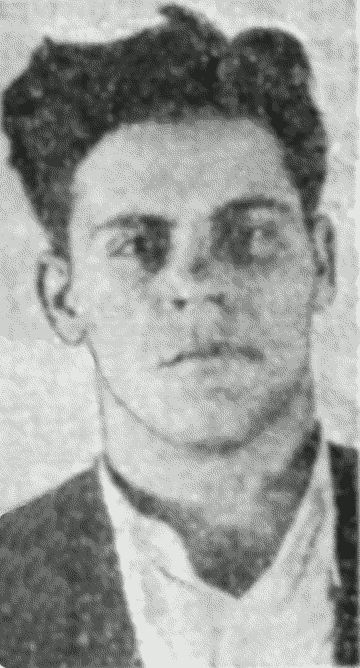
Pranno in 1934
Rocco Pranno was born December 18, 1916, in Melrose Park, Illinois, a suburb of Chicago known for its large Italian population. He was the son of Louis and Stella Pranno. His father was a Calabrian immigrant who came to the United States in 1902. [5] His mother was born in Chicago. [6] Pranno's father owned a grocery store that sold fruit and vegetables.
The Pranno family was poor but better off than many others in the neighborhood. Most neighbors rented their homes while Rocco's parents owned theirs. It had a value of $8,000 in 1930. That was slightly higher than the average home price in the country at that time. According to the 1930 census, they were one of the only families on their block that owned a radio.
Pranno attended school intermittently before he dropped out early. [7] A month before he turned eighteen, Pranno married Martha Jennings in Lake County, Indiana. By then, he had already committed to a life of crime.
Hoodlum in Training
At the age of seventeen, police arrested Pranno for robbing a currency exchange bank. As he was getting out the police cruiser at the station, Pranno attempted to escape by jumping into the nearby Des Plaines River and swimming to the other side. Police chased after Pranno and fired warning shots into the air to force him to surrender. According to police, Pranno returned to shore "dejected." [8] Around the same time, police arrested Pranno again for robbing a bank in Michigan. [9]
At the age of eighteen, Pranno pleaded guilty to being part of a four-man "golf club gang" that robbed golf courses in Illinois and Wisconsin. [10] The judge sentenced him to a year to life in prison. As part of his plea deal, Pranno told investigators where to find the guns and burglary equipment used in the heists. [11] Pranno also admitted that the gang had next planned to rob a bank. Michael Moreno, a member of the "golf club gang," would remain a lifelong criminal associate.
The same year, police arrested Pranno and his gang for robbing rail passengers on the Illinois Central Railway. The "hair-trigger bandits" as the newspaper called them were caught and confessed to their crime. [12] It's unclear how much time Pranno spent in prison for these crimes, but he was incarcerated at the Illinois State Reformatory and Hospital in 1940. [13]
In the 1940s, Pranno was caught by police in the act of burglarizing a store in Melrose Park. After being confronted by police, Pranno drew his revolver and fired it at police, but it misfired. Police charged Pranno with burglary and robbery, but his underworld connections had the charges reduced to malicious mischief, and he served only thirty days in prison.
Pranno and his older brother Albert Pranno were part of a criminal gang that robbed department stores. They were arrested in 1951, when police discovered stolen clothing with a value of $20,000 in the basement of a home occupied by Pranno's sister. [14]
In 1962, Pranno spent ten days in the county jail after being convicted of driving with a suspended license. Officials revoked Pranno's driving privileges in 1957 after a series of violations, including multiple speeding tickets and driving accidents. According to state investigators, his driving record was one of the worst compiled in the entire state. [15] Officials charged Pranno with driving with fraudulent driver's licenses under multiple false identities and lying on his driving application. He also had a rape conviction. [16]
Outfit connections
Pranno became a crew boss sometime in the late 1950s when Sam Giancana took control of the Outfit. Pranno controlled territory in the Villages of Stone Park and Franklin Park and the City of Northlake, communities near Cook County's border with DuPage County. Much of this territory was once under the supervision of Rocco DeGrazia, an old associate of Al Capone. Pranno likely started under DeGrazia and "made his bones" under him. Pranno probably became an inducted LCN member in 1956 when a large number of his criminal peers like Felix Alderisio and Charles Nicoletti were known to have entered "the Life" and become LCN members.
As crew boss, Pranno reported to Giancana's lieutenant Sam Battaglia. Battaglia controlled the faction of the Outfit called the Westside. According to some reports, Pranno's relationship with Giancana wasn't the best, although he was close to Battaglia. Members in Pranno's crew included his brother Albert, Joseph "Joe Shine" Amabile, Guido Dechiaro, and Sam Ariola. Pranno was respected enough to have attended the wedding of Outfit bigwig John Cerone's son Jackie in 1961.
Coin-operated machines
Pranno thrived operating coin-operated machines and gambling parlors in the western suburbs of Chicago. The machines, which included jukeboxes and prophylactic-dispensing devices, were found in bars and restaurants everywhere. Along with other Outfit associates, including Charles English and Francis Curry, Pranno would use threats of violence to terrorize competitors into selling their businesses to mob-connected firms, often at a steep discount. [17]
In 1959, Pranno was called before the United States Senate Rackets Committee investigating the underworld infiltration of the jukebox industry in the Chicago-area. A witness told investigators how Pranno muscled into one coin-operated machine business after he tied the owner's legs to cement blocks and threatened to throw him into the river unless he made Pranno a partner. [18]
Pranno used violence freely. He was a suspect in the 1962 murder of gangster Octavio Martinez and his girlfriend. Martinez allegedly acted as a "frontman" for Pranno as he attempted to expand his control over coin-operated machines in the Rockford, Illinois-area. Police accused Pranno of distributing narcotics using the network. According to investigators, Pranno had supplied Martinez with "substantial" money to purchase and install the machines. The Outfit allegedly killed Martinez when he was unable to repay the loans and attempted to "double-cross" Pranno.
Stone Park and the Key Lounge
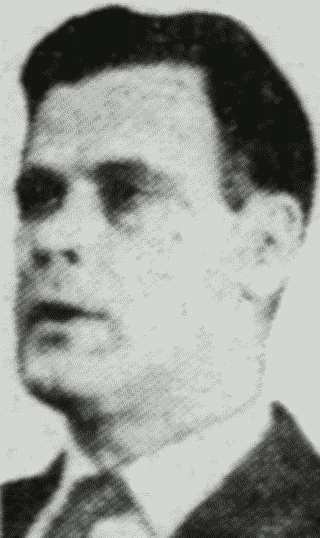
Pranno, 1960s
Part of Pranno's criminal success was tied to his ability to corrupt legitimate authority to serve criminal ends. Pranno's corrosive influence was on full display in Stone Park.
By 1960, Pranno controlled every political office in Stone Park with the help of his brother. Albert Pranno headed up the Independent Party. Albert was the political rainmaker who made backroom deals with politicians and business people, and whose endorsement was necessary to win an election. Rocco Pranno worked side by side with elected officials to rig the system and extort businesses to his advantage. Pranno moved fearlessly through the community because his cousin, Andrew Signorella, was the Stone Park police chief. [19] Signorella protected Pranno and his criminal enterprises.
Because of his connections, Pranno ran wild through town. Twice, he assaulted ordinary citizens in unprovoked attacks. In one instance, Pranno attacked a man over an argument about city politics. As he hit the victim, he yelled at him, "Don't you know who runs this town?" Police later dismissed the charges against Pranno. [20]
Another time, Pranno beat up a man after he refused to move his truck parked in front of Pranno's social club. [21] The beating took place in full view of a Stone Park police officer who refused to intervene. [22] Police chief Signorella declined to follow up on the victim's complaint. Charges were only laid against Pranno after state investigators became involved. The victim later declined to press charges, and Pranno skated.
Pranno flaunted his political power. He used his pull with the town council to get city workers to build a private pool on property owned by his mob superior Sam Battaglia.
Pranno's power base was the Key Lounge (also known as "Key Club" and "Club d'Or"), a "plush" cocktail lounge at 1745 North Mannheim in Stone Park. [23] Pranno used the Key Lounge as a clubhouse to conduct criminal business. Sam Giancana's son-in-law was the manager. [24] Pranno used "Jim Martel" as an alias around the lounge. He was a "sharp dresser" and a ladies man. [25] The lounge was a place where members could gamble and drink in a beautiful setting. It contained slot machines, dice, and roulette tables. [26] Prostitutes were also available for clients. [27] Pranno was rarely bothered by police despite the ongoing criminal activity.
Pranno terrorized his employees at the Key Lounge. He nearly beat to death an employee for stealing; the assault lasted a half-hour before the man was tossed bleeding on the sidewalk. He also beat up two waitresses who got on the wrong side of him. [28] None of the victims dared complain to the police.
Shakedowns
Pranno used his political connections to organize an elaborate shakedown operation in the Stone Park/Northlake-area. Pranno's cronies on the town council forced manufacturing companies to pay thousands of dollars in bribes to obtain permits to build factories. Other companies faced having their building sites shut down mid-construction unless they paid additional fees. Pranno and his co-conspirators on the town council split the money.
The extortion racket was lucrative, but it would be Pranno's downfall. Companies started balking at paying the fees, and the scheme fell apart. Officials charged Pranno, a town alderman, and the building commissioner with extortion. Pranno was also charged with tax evasion on income of over $100,000. [29]
The Outfit bosses provided Pranno with a high-priced attorney in his defense, but the evidence was overwhelming, and he was found guilty at trial. On March 9, 1966, a judge sentenced Pranno to a prison term of fifteen years. [30] Pranno cried as he was led away in handcuffs. [31] The court denied Pranno bail while he was appealing his sentence.
Twenty-six-day bender
Pete Anderson, the former Northlake building commissioner, convicted with Pranno in the extortion conspiracy, failed to surrender on time. [50] Instead, he went on a twenty-six-day drinking binge at his fishing cabin. After he finally surrendered to prison officials, Anderson's lawyer, Richard Devine, said it was his client's first encounter with alcohol in twenty-two years, and begged for the court's understanding.
Pranno speaks
Part of Pranno's original motivation for cooperating was his hope that the FBI could get him released on bail. That never happened, and Pranno lost his appeal in 1968. Nonetheless, Pranno continued to help the FBI. For example, agents went to him in prison in 1973 for information about C. August Taddeo, the newly appointed mayor of Melrose Park. Pranno grew up in Melrose Park and knew the players well.
Pranno explained that the rumor that Taddeo was Outfit Leader Joseph Aiuppa's nephew was false. Taddeo, he said, was Aiuppa's godson, and Aiuppa had always watched over him. [32] According to Pranno, Aiuppa paid for Taddeo's law school tuition and gave him his start after graduation. However, Pranno was disdainful of Taddeo's abilities. He said Taddeo was a poor attorney and would have never amounted to much without Aiuppa's help. [33]
(C. August Taddeo was supervisor of Proviso Township from 1969 to 1999. He also served as mayor of Melrose Park, a village within Proviso, from the 1972 death of Mayor Jacob LaSpisa until spring 1997. He was convicted in 1999 of federal extortion and tax charges and was sentenced to twenty-seven months in prison.)
Pranno told agents that Melrose Park attorney Barney Bruno was a close associate of Outfit leaders Aiuppa and Charles Nicoletti. According to Pranno, Bruno acted as a "courier" for Aiuppa and Nicoletti when they needed to get secret messages to imprisoned Outfit leaders Sam Battaglia or John Cerone.
Pranno identified Fiore Buccieri and William Daddano as Outfit members. [34]
Anger at the Outfit and fear of prison drove Pranno into the arms of the FBI. How much help he ultimately gave the FBI is unknown. The full extent of his relationship lies buried in his classified FBI informant file. The information outlined here is likely only a small sample of what he said to the FBI. Pranno was off the street before he started talking, so any value he might have had laid mostly in providing background information on Outfit members and the history of the organization.
Despite feeding information to the FBI, Pranno never tasted freedom again. He died in prison in 1979, at the age of sixty-two. The FBI never disclosed Pranno's secret relationship. He was buried in Hillsdale, Illinois.
Anthony Amatore
Anthony Amatore was born August 26, 1926, in Chicago, the youngest child of Vincent and Santa Amatore. His parents were Italian immigrants. [35] Amatore grew up in the Homan Square-area of Chicago.
Amatore joined the Village of Stone Park Police Department in the late 1950s. He made the papers at least once for good police work when he thwarted the hijacking of a truck filled with $50,000 worth of televisions, stereos and radios. After stealing the merchandise, the hijackers parked the stolen truck in a parking lot next to the police station and went for a bite to eat. Amatore and his partner spotted the stolen vehicle and promptly arrested the hijackers when they tried to flee. [36] Amatore rose to the rank of lieutenant on the small Stone Park police force.
How Amatore became connected to the Outfit is unknown. It was likely through his close friend Rocco Pranno, but the available FBI reports don't provide any clues.
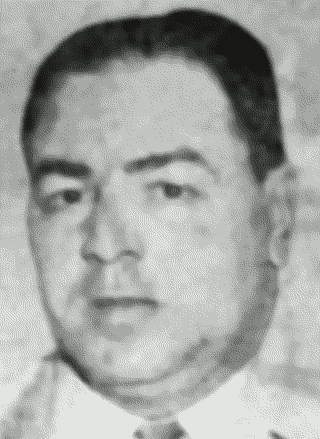
Signorella
While he was still a member of the Stone Park police, Amatore appeared as a defense witness for Patrick Schang, one of five individuals involved in the armed robbery of the Franklin Park Bank in 1963. [37] The robbers were associated with the Outfit. Amatore testified he saw Schang, the getaway driver in the heist, in a restaurant many miles away from the bank at the time of the robbery. A jury convicted Schang at trial, suggesting they didn't believe Amatore's testimony. (Later on, Schang became a police informant. He testified that he did participate in the robbery. He said Amatore's alibi testimony was a coincidence that worked in his favor).
Rocco Pranno's influence thoroughly corrupted the Stone Park police force. The crime rate soared under police chief Signorella with home burglaries becoming commonplace. Residents protested the lack of police action against the thieves, but nothing seemed to change.
In 1960, Police Chief Andrew Signorella was arrested for accepting a $125 bribe to toss out a criminal case against a resident. The arrest was part of a sting operation launched by state investigators after numerous complaints about Signoralla's behavior. The case against Signorella was dropped after the complaining witness refused to testify.
Eventually, pressure from the residents of Stone Park persuaded politicians to reorganize the police force. In 1964, Signorella was forced to resign, and Amatore was fired. Amatore had been a member of the police force for seven years.
"I have decided to let go Mr. Amatore go," the mayor said. "It will be for the good of the force. There have been too many burglaries. We are going to rebuild our police force and we are going to get on thieves around here." The mayor added that "thieves had better get out or we'll kill them." [38]
Amatore's connection to the Outfit seems to have faded after Pranno's incarceration. Pranno appears to have been his conduit to the Outfit. After Amatore was fired, he worked as a truck driver. He died in 2006.
LCN member or associate
Anthony Amatore's relationship with the FBI began sometime before January 1967. By then, Amatore was already considered a Top Echelon informant or "C-TE" of the FBI's Chicago office. The most critical informants are assigned this designation after a period of discernment by the FBI. If Amatore were a new informant, he would have been designated a "PC" or potential criminal informant. His top echelon designation suggests Amatore started talking in 1966 or earlier.
Levels of informants
Information compiled from secret informants makes up the backbone of FBI reports. But not all informants are created equal. A member-informant in the Outfit is generally in a better position to provide accurate information than a low-level associate who might be hearing news secondhand. Identifying a source gives researchers the benefit of knowing how much weight to give him.
Amatore's law enforcement background raises questions about his actual status in the underworld. Typically, a member of law enforcement would be ineligible to become a La Cosa Nostra member. The rules against ties to law enforcement were so strict that even having a relative as a cop could preclude membership. For example, Gambino Crime Family member John "Johnny Roberts" Robilotto was initially blackballed by the Genovese Crime Family because his brother was a police officer.
But the Chicago Outfit was a unique blend of Italian and non-Italian gangs with a different history than East Coast LCN families. Richard Cain, a former Chicago-based law enforcement officer, also claimed he was an LCN member in the Outfit. [39] Amatore was identified as an inducted LCN member by Louis Fratto in 1967. And the FBI reiterated Amatore's LCN membership in a 1976 FBI report. [40]
Doubts remain, though. Pranno failed to identify Amatore as an LCN member in 1968 when given the opportunity (though perhaps he was protecting his friend). Nor did Milwaukee LCN member-informant August Maniaci, who provided the names of dozens of Outfit members. [41]
Amatore opens up
Amatore relayed essential details to the FBI about Sam Giancana's state of mind in 1966. Amatore picked up his Intel directly from Rocco Pranno after meeting with him at Terre Haute in January 1967. [42] (Even though Pranno was an informant by this time and could have shared this information to the FBI directly, it appears he wasn't as forthcoming as Amatore.)
Before Pranno transferred to Terre Haute, he told Amatore that he spent time locked up with Sam Giancana at the Metropolitan Correctional Center in Chicago. Giancana, the former boss of the Outfit, was serving a one-year prison sentence for contempt. Giancana had refused to testify before a grand jury despite being given immunity. Pranno said that Giancana didn't handle his incarceration very well and was a broken man.
Pranno advised Amatore that Giancana "was completely disgusted with his circumstances and indicated his morale was completely shattered." [43] Giancana cursed out his old Outfit associates and told Pranno that once he got out, he intended to "leave everything behind. They can have everything I got." Amatore told agents that Giancana intended to "disassociate" himself from organized crime and "go to an island and relax for the rest of his life."
Pranno told Amatore that Giancana believed the government would only leave him alone if he quit as boss. Otherwise, the government would call him before another federal grand jury and stick him in jail again. (Some reports suggest Outfit leaders Anthony Accardo and Paul Ricca forced Giancana out as boss, but it was more likely a mutual decision.)
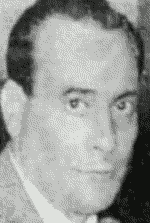
Bruni
Pranno advised Amatore that it was possible Giancana had "flipped" and worked out a "deal" with the government because the former boss hasn't been harassed by law enforcement or issued with a subpoena since leaving prison. From Pranno's comment, it's unclear if the Outfit leadership also suspected Giancana had flipped.
Pranno told Amatore that Giancana had given him his watch and ring when he left jail. Pranno was wearing the watch when he arrived at the Terre Haute Penitentiary. Wristwatches were a prohibited item in prison and other inmates "beefed" that Pranno was receiving privileges because he was an Outfit big shot. Pranno had to remove the watch as a result.
Pranno complained to Amatore that his Mafia reputation had preceded him into prison. Other inmates like Anthony Accardo's former personal physician Dr. Giulio Bruni kept trying to hang around him and curry his favor. Bruni was in jail on a counterfeiting charge. Pranno said Bruni was depressed because his wife never visited him.
During his visit to the penitentiary, Amatore said he saw Bruni himself, and he looked "broken up." Amatore told agents that another Outfit associate named Tony D'Antonio, a convicted bank robber, looked "cracked up." Pranno advised Amatore that D'Antonio would be transferred to Federal Hospital in Springfield, Missouri.
Amatore told agents in January 1967 that Giancana was residing in Mexico. Other sources like Ralph Pierce were telling the FBI the same thing. Amatore said that Outfit leaders blamed Giancana's decision to sue the FBI for the government's "intensified" investigation into the Outfit. Outfit leaders believed the investigation would have been less "severe" if Giancana had put up with the FBI as a "necessary evil" just like every other boss had in the past. [44]
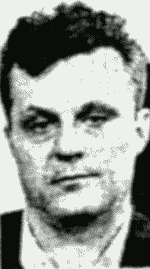
D'Antonio
Pranno was unhappy with his attorney's defense during his trial. He told Amatore that he threatened to kill Richard Devine because he did the job of "a fourteen-year-old kid." Pranno said he was going to have a stenographer in court during his appeal to be certain Devine represented him adequately.
Amatore advised agents that Pranno's wife complained to her husband in front of him that an Outfit associate named Mike Moreno was coming to her home and asking questions. (The FBI called him "Mike Marino" in the report. Moreno had known Pranno for decades). Amatore thought Moreno was a spy for the Outfit bosses.
An incensed Pranno advised his wife to spit in Moreno's face next time and tell him he told her to do it. (The irony, of course, was Pranno was talking with the FBI and the Outfit had good reason to be concerned about him.)
After Pranno went to prison, his underling, Joseph "Joe Shine" Amabile was bumped up to replace him as the new boss of the Stone Park/Northlake crew. Pranno told Amatore that the government was investigating Amabile now. Pranno hated Amabile, but he advised Amatore that he would never testify against him and would take the Fifth Amendment if necessary. (Amabile would eventually be found guilty of extortion in a scheme connected to Pranno's rackets.)
Initiation rites
Amatore advised that there was no formal initiation ceremony into the Outfit. Every candidate for membership had a sponsor who evaluated his "performance" and "tested" him with different "assignments." If the individual were deemed worthy by his sponsor, he would meet with a group of senior Outfit members for further evaluation. They would question him more or give him additional assignments to test him. If the panel was satisfied, the candidate was notified by his sponsor that he was "in" or "made." Once accepted as an Outfit member, an individual could never refuse a request of the organization. [51]
Amatore names names
As the FBI ramped up its investigation of La Cosa Nostra in the 1960s, a primary goal set by FBI Director J. Edgar Hoover was to identify every member. FBI offices were required to compile a list of LCN members in their areas and determine the leadership groups. The best and most accurate way to determine LCN membership, according to the FBI, was through member-informants like Amatore.
Amatore identified over forty Outfit members for the FBI. Amatore was the first Outfit member informant to confirm the LCN membership of Steve Annoreno. [45] In the 1960s, Amatore identified more Outfit members than any other Chicago member-informant except for Louis Fratto.
Amatore helped to clarify for the FBI who was leading the Outfit and setting policy after Sam Giancana and Sam Battaglia were jailed. In August 1968, Amatore told agents that "[Tony] Accardo and [Paul] Ricca continue to share the leadership responsibilities for the LCN Chicago 'family.'" [46]
In January 1973, Amatore advised the FBI that Joseph Aiuppa was the "top man in the Chicago area under a Board of Directors including Tony Accardo, Dominick Di Bella, and several other senior members." [47] He said that Aiuppa wasn't feeling well and "[was] looking for someone to take over his responsibilities." [48]
In August 1976, Amatore was contacted by the FBI for information about the recent assassination of mobster Johnny Roselli in Florida. Roselli was a former Outfit member who was Giancana's point man in the Mafia/CIA plot to kill Fidel Castro. Officials were pressuring Roselli for information because the Italian-native was living in the United States without proper documentation.
Amatore didn't have any specific information about Roselli's murder. He told agents that "Roselli was known to be talking in an effort to avoid deportation... and [his] cooperation with the government in any way would be 'cause for any the [LCN] families to knock him off'". [49]
Only a small number of FBI documents that are publicly available contain information linked to Anthony Amatore. (The disclosures are linked to "CG 6933," suspected of being Amatore.) He likely told the FBI much more, but the information is still classified.
Notes
1 FBI, Top Echelon Criminal Informant Program, Chicago Office, Jan. 20, 1967, NARA Record No. 124-90059-10073.
2 Devine had been hired by Outfit leader Felix Alderisio to defend Pranno.
3 The report only indicates that the FBI learned of the information on Jan. 19, 1967, and that the visit occurred "recently." Pranno's wife likely returned home from the prison visit and contacted the FBI soon afterward.
4 FBI, Top Echelon Criminal Informant Program, Chicago Office, Jan, 20, 1967, NARA Record No. 124-90059-10073.
5 United States Census of 1920, FamilySearch.org.
6 United States Census of 1930, FamilySearch.org.
7 United States Census of 1940, FamilySearch.org.
8 "Berwyn stickup suspect tries to swim to safety," Cicero Life, June 18, 1934.
9 "Villa Park bank robbed," Chicago Tribune, May 3, 1934.
10 "Terms break up 'Golf Club Gang,'" La Crosse Tribune, Sept. 13, 1935.
11 FBI, Samuel Giancana, Chicago Office, May 5, 1961, NARA Record No. 124-90024-10122.
12 "Holdup of I.C. train admitted by bandits," Pantagraph, Sept. 5, 1935.
13 United States Census of 1940, FamilySearch.org. Despite being married, Pranno indicated he was single.
14 "Arrest gang with $20,000 clothes loot," Chicago Tribune, Feb. 12, 1951.
15 "State to ask hood's arrest for perjury," Chicago Tribune, Dec. 28, 1962.
16 "U.S. jury convicts three of extortion," Southern Illinoisan, March 10, 1966.
17 "Syndicate invades Kane vending firm," Chicago Tribune, May 20, 1966.
18 Moore, William, "Illinois juke box terror told," Chicago Tribune, Feb. 20, 1959.
19 Signorella was married to Pranno's wife's sister.
20 "Teacher says gang gaming boss beat him," Chicago Tribune, June 23, 1963.
21 "Mess in Stone Park," Chicago Tribune, Oct. 19, 1962.
22 FBI, Samuel Giancana, Chicago Office, August 1, 1961, NARA No. 124-10297-10193.
23 FBI, Samuel Giancana, Chicago Office, May 5, 1961, NARA Record No. 124-90024-10122. The Key Lounge eventually became the "D'Ors Club."
24 FBI, Samuel Giancana, Chicago Office, April 21, 1961, NARA Record No. 124-10293-10194.
25 FBI, Samuel Giancana, Chicago Office, May 5, 1961, NARA Record No. 124-90024-10122.
26 FBI, Samuel Giancana, Chicago Office, April 24, 1961, NARA Record No. 124-10226-10341.
27 FBI, Samuel Giancana, Chicago Office, April 26, 1961, NARA Record No. 124-10293-10206.
28 FBI, Samuel Giancana, Chicago Office, May 31, 1961, NARA Record No. 124-10226-10357.
29 "U.S. indicts mayor in extortion plot," Baltimore Evening Sun, Aug. 4, 1965.
30 "Tower ticker," Chicago Tribune, June 19, 1972.
31 "Pranno gets 15-year sentence; deny bail," Chicago Tribune, April 28, 1966.
32 FBI, Joseph John Aiuppa, Chicago Office, April 20, 1973, NARA Record No. 124-10196-10353. Taddeo's father Vic Taddeo was a dealer in card games controlled by Aiuppa.
33 "Three convicted of crime quit as tavern owners," Berwyn Life, June 7, 1957. In the 1950s, Aiuppa and Felix Taddeo were business associates in a Cicero tavern.
34 FBI, La Cosa Nostra, Chicago Office, September 25, 1967, NARA Record No. 124-10293-10279. T-12 is Pranno.
35 United States Census of 1930, FamilySearch.org
36 "5 hijackers caught after parking error," Chicago Tribune, Dec. 2, 1962.
37 United States Court of Appeals for the Seventh Circuit, July 24, 1966, United States of America vs. Joseph D'Argento et al.
38 "Police chief, 2nd officer out in Stone Park," Chicago Tribune, March 31, 1964.
39 FBI agent William Roemer said Cain was an LCN member. However, informants from the period, including Amatore, Pranno, Fratto, and August Maniaci, never confirmed his membership despite identifying dozens of other members. This omission suggests Cain lied to the FBI or his LCN membership wasn't widely known for some reason. Cain's dubious claims of Italian ancestry may have also played a part in precluding his LCN membership.
40 FBI, John Roselli, Chicago Office, Aug. 14, 1976, NARA Record No. 124-10351-10097.
41 FBI, La Cosa Nostra, New York Office, October 10, 1967, NARA Record No. 124-10277-10308. T-48 was A. Maniaci, T-190 was L. Fratto, and T-191 was A. Amatore.
42 Pranno likely shared this information with Amatore in front of Martha Pranno.
43 FBI, Samuel Giancana, Chicago Office, January 19, 1967, NARA Record No. 124-10198-10174. FBI, Samuel Giancana, Chicago Office, March 23, 1967, NARA Record No. 124-10208-10036.
44 FBI, Samuel Giancana, Chicago Office, March 23, 1967, NARA Record No. 124-10208-10036.
45 FBI, La Cosa Nostra, Chicago Office, August 23, 1968, NARA Record No. 124-10288-10421.
46 FBI, La Cosa Nostra, New York Office, September 26, 1968, NARA Record No. 124-10290-10437. T-204 is Outfit associate Mike LaJoy (CG 7211). LaJoy provided the FBI with similar Intel. LaJoy was a paid FBI informant between January 1963 and January 1972. He was dropped as an informant in February 1972 after he was arrested for armed bank robbery.
47 FBI, Joseph John Aiuppa, Chicago Office, March 7, 1974, NARA Record No. 124-10196-10354.
48 FBI, Joseph John Aiuppa, Chicago Office, March 7, 1974, NARA Record No. 124-10196-10354.
49 FBI, John Roselli, Chicago Office, August 14, 1976, NARA Record No. 124-10351-10097.
50 "Ex-official sobers up, goes to jail," Chicago Tribune, July 12, 1966.
51 FBI, La Cosa Nostra, Indianapolis Office, Aug. 22, 1968, NARA Record No. 124-10297-10126.
